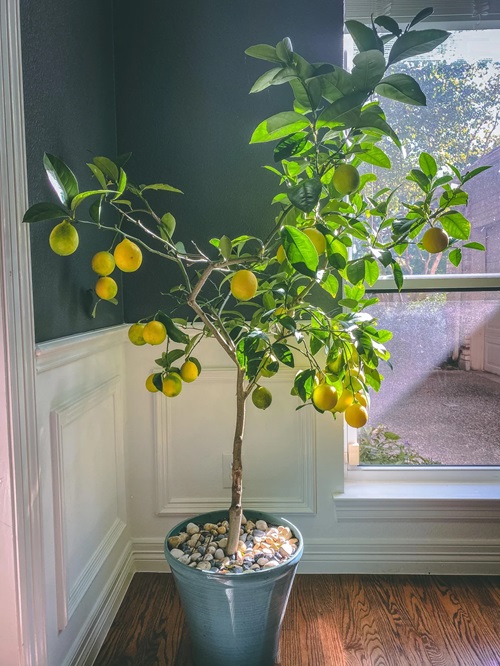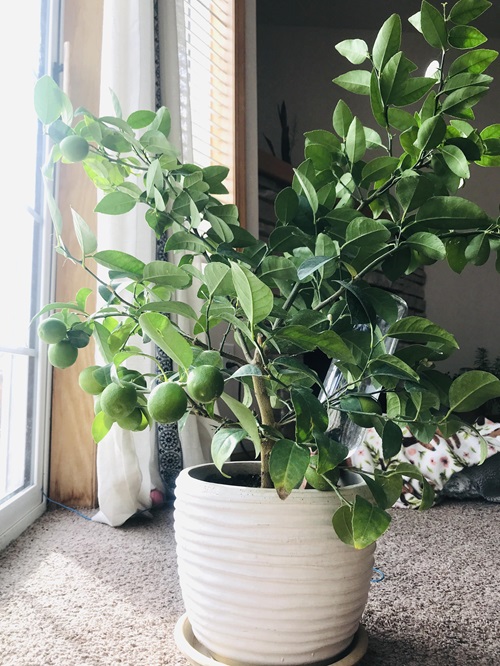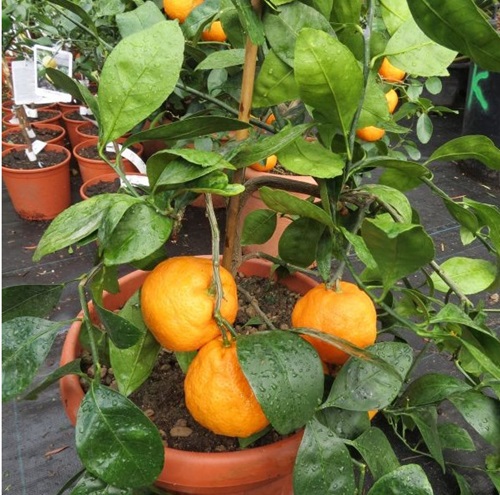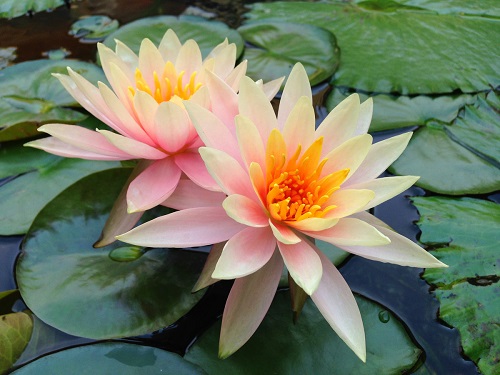When life gives you lemons, you grow them at home! Here are the best dwarf citrus trees you can grow indoors in winter.
Citrus fruits have quite a reputation for being difficult. From space to fruiting time, there are so many factors to consider while planting these moody but refreshing species. Hence, we have curated a list of the best dwarf fruits to grow indoors during winter!
Best Dwarf Citrus Fruits to Grow Indoors in Winter
1. Meyer Lemon

Botanical Name: Citrus x meyeri
First, we have the hybrid Meyer lemon, a cross between a mandarin and a lemon. Featuring fragrant white blooms and dark green leaves, the Meyer lemon is an absolute favorite among chefs because of its edible aromatic yellowish-orange peels.
The best part is Meyer lemons are one of the easiest dwarf citrus trees to grow indoors. Choose a foam or lightweight plastic container with enough room to grow.
While seed-grown Meyer lemon trees can take 3-7 years to fruit, grafted Meyer lemon can fruit in a year or two. These trees need feeding three times during the active growing phase with an all-purpose or high-nitrogen fertilizer.
2. Kaffir Lime

Botanical Name: Citrus x hystrix
Native to Southeast Asia, where it is often called Thai lime, Keifeer lime, or makrut, Kaffir lime can be an absolute treat to grow indoors! With stunning round dark green to bright fruits, the plant also fills your home with a beautiful, lemony scent.
This dwarf hybrid variety needs ample sunshine and balanced fertilizers to flourish. Prune back in spring just before it starts showing vigorous new growth. This will allow the plant to produce fruit quickly and remain compact.
3. Key Lime

Botanical Name: Citrus × aurantiifolia
The dwarf Key lime prefers lounging in the outdoor sun. If you have a patio, balcony, or even a south-facing window that gets long hours of sunshine, it’s the perfect spot for this delicious citrus tree.
During summers, it produces beautiful, fragrant star-shaped white flowers and sour limes that even give the famous pie its name! While the fruits are harvested when green, they turn a sunny yellow as they ripen.
However, as the mercury dips below 55 F (12 C), it’s time to bring your Key lime indoors to overwinter. Keep your Key lime at temperatures above 70 F (21 C) indoors, and use grow lights to make up for less sunshine during winter.
4. Calamondin Orange

Botanical Name: Citrus × Citrofortunella mitis
Also called Calamansi, this is the most common type of citrus tree grown indoors. Calamondin fruits are small and sour, like lemons or limes, and are often used in cooking. The tree needs a large enough container to allow its roots to spread.
This orange prefers soil with ample drainage to prevent root rot. The soil should be somewhat acidic; add peat moss, vermiculite, or perlite alongside manure or compost to amend and enrich the medium.
5. Satsuma oranges
Botanical Name: Citrus unshiu
Satsuma oranges are one of the most cold-hardy citrus trees. They produce abundant harvests of the sweetest fruits even when grown indoors. Satsuma is a small to medium-sized plant with a droopy, spreading growth habit.
The best season to plant this tree is spring, when it puts out fragrant, pollinator-attracting white blooms. If growing from seed, it will take about eight years for fruit. However, you can cut short that long wait a year or two with grafted plants.
The fruit contains 10-12 segments of sweet, juicy flesh wrapped in easy-to-peel leathery skin. To grow inside your home, pick cultivars like ‘Owari,’ ‘Brown Select,’ ‘Silverhill,’ and ‘Early St. Ann.’ And did you know you can use citrus peels in the garden?
6. Kumquat

Botanical Name: Fortunella japonica
Our final candidate in our list of best dwarf citrus trees to grow at home is the classic kumquat! A name derived from the Cantonese term “gam-gwat” which means “golden orange”, kumquat is a small citrus fruit with a sour, thin flesh.
With at least six hours of daily sunlight, kumquat trees will produce fruit every winter when grown in pots indoors. And here are a few more citrus fruits to grow in pots.
How to Care for Your Indoor Dwarf Citrus Tree

Most of the dwarf varieties mentioned above have similar grow needs. Here are a few tips for coaxing them to fruit as houseplants.
1. Acidic Soil for Tangy Fruits
Most citrus trees thrive and fruit best in loam-based, slightly acidic mediums. Go for a potting mix comprising sand, silt, and clay in a 2:2:1 ratio. And use peat in the mix to keep the pH down.
2. Citrus Plants need Humidity
Dwarf citrus trees need about 50 % humidity when growing indoors. Especially in winter, when the air tends to dry out, spritz your plants occasionally with water or invest in a humidifier.
3. Tepid Watering for Citrus Trees
It’s easy to shock your citrus plant with extra chill water during fall and winter. Remember to use tepid or room temperature water, and hydrate early morning so the plant stays quenched even as the sun takes over. The soil needs to be moist but never soggy.
4. Lots of Sunshine for Indoor Citrus Plants
Dwarf citrus trees need 6-8 hours of sunlight daily to flourish. When growing indoors, either place them near an east-facing glass window, a south-facing window with sheer curtains, or artificial grow lights.
5. Hand-Pollinate Indoor Citrus Fruit Trees
Though most dwarf citrus trees are self-fertile, you may have to hand-pollinate when growing them indoors in winter. Use a small dry toothbrush to gently shake and spread the pollen from one flower into the next.
And that’s all about growing citrus trees indoors. Which dwarf citrus trees are your favorite and why? Let us know in the comments below!


